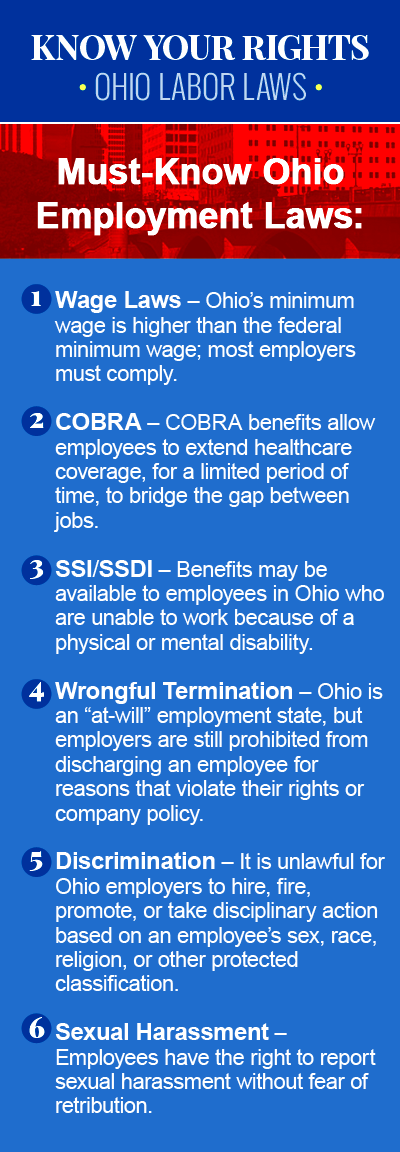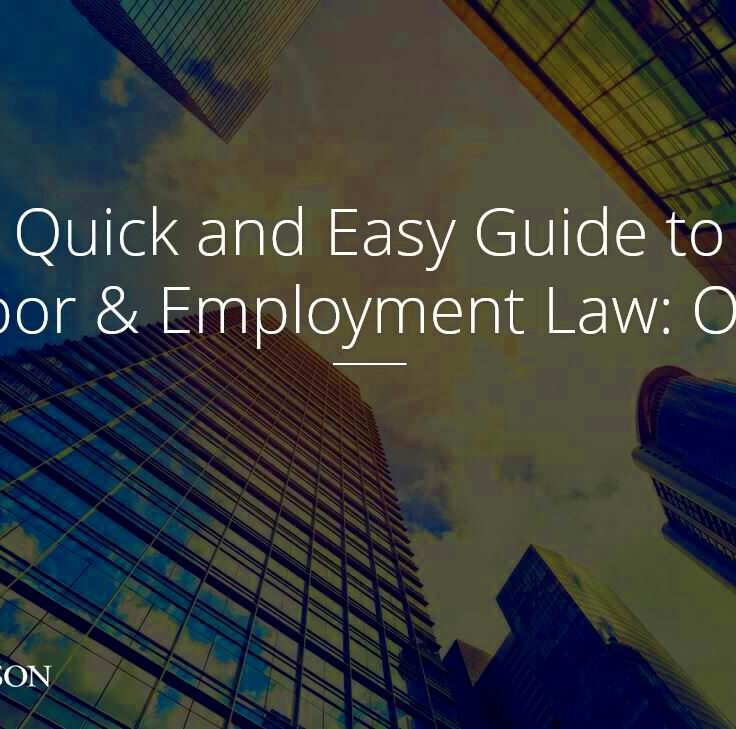Understanding Ohio Employment Laws
Ohio’s labor regulations define the obligations and rights for both employers as well as employees. Various areas including remuneration, standards and conditions of work together with workers’ rights are encompassed within these rules thus promoting justice at places of work. It is important that anyone earning a living in Ohio or planning to take up a job in that state has an understanding of them. Important laws, protections for employees and significant aspects of employment will be examined in this document.
Key Employment Laws in Ohio

Numerous significant labor laws exist in Ohio that regulate diverse components of the job. These comprise:
- Ohio Minimum Wage Law: This law sets the minimum wage that employers must pay their employees. As of 2024, the minimum wage in Ohio is $10.10 per hour.
- Ohio Revised Code Section 4111: This outlines regulations concerning wage payment and collection, ensuring employees are paid timely and fairly.
- Family and Medical Leave Act (FMLA): While a federal law, Ohio adheres to FMLA, allowing eligible employees to take unpaid leave for specific family and medical reasons.
- Ohio Workers’ Compensation Act: This law provides benefits to employees injured on the job, ensuring they receive medical care and wage replacement.
The implementation of these laws leads to an enhanced state of equity in the workplace since they stipulate the anticipations of both parties concerned.
Employee Rights and Protections
The employees who work in Ohio have a number of different rights and protection mechanisms as well intended to create a safe and fair workplace. Some of the important rights that employees enjoy include:
- Right to Fair Wages: Employees must be paid at least the minimum wage and are entitled to overtime pay for hours worked beyond 40 in a week.
- Protection Against Discrimination: Employees cannot be discriminated against based on race, color, religion, sex, national origin, age, or disability. The Ohio Civil Rights Commission enforces these protections.
- Right to a Safe Workplace: Employees have the right to work in an environment that is free from hazards. Employers are required to comply with the Occupational Safety and Health Administration (OSHA) standards.
- Right to Take Leave: Employees may take leave under the FMLA for specific family and medical reasons without fear of losing their jobs.
Comprehending these entitlements is essential for workers to fight for their own rights and ascertain that they get treated justly at their places of work.
Wage and Hour Regulations in Ohio
For both employees and employers, it is important to understand the wage and hour laws in Ohio. These regulations determine not only how much should employees be paid, but also when they get their paychecks as well as the number of hours they can work in a week. However, understanding these rules may prove difficult because Ohio considers both state and federal laws. The key points are:
- Minimum Wage: As of 2024, the minimum wage in Ohio is $10.10 per hour for non-tipped employees. Employers must adhere to this law, and penalties may apply for violations.
- Overtime Pay: Employees who work over 40 hours in a week are entitled to receive overtime pay, calculated at 1.5 times their regular rate. Certain exemptions may apply, so it’s essential to understand your classification.
- Meal and Rest Breaks: Ohio law does not mandate meal breaks, but if an employer provides breaks, they must be at least 30 minutes long to be unpaid. Short breaks under 20 minutes must be paid.
- Pay Frequency: Employers in Ohio are required to pay employees at least twice a month. Failure to comply with this can result in legal repercussions.
By understanding this rulebook, workers can be aware of their entitlements while companies do not hesitate with the law keeping away from any nasty experiences or facing penalties that would have been avoided had they acted responsibly.
Workplace Safety Standards
In Ohio, ensuring a safe work environment is of utmost importance, and is controlled by both the state and federal laws. The Ohio Occupational Safety and Health Administration (OSHA) plays critical role in enforcing safety measures for the welfare of employees from health risks. Some major points include:
- General Duty Clause: Employers must provide a workplace free from recognized hazards that could cause serious harm or death.
- Hazard Communication Standard: Employers are required to inform employees about hazardous chemicals they may be exposed to and provide necessary training.
- Personal Protective Equipment (PPE): Employers must provide appropriate PPE at no cost to employees when required to protect against workplace hazards.
- Reporting Requirements: Serious workplace injuries must be reported to OSHA within a specified timeframe. Failure to report can result in fines and penalties.
Observing these regulations contributes to the lessen of the odds destroy or injures at work for which both workers and their bosses are accountable, making it a healthier world of work.
Unemployment Benefits and Eligibility
Unemployment benefits help employees who have been laid off without any mistake of theirs. The Ohio Department of Job and Family Services (ODJFS) controls unemployment insurance program in Ohio. What should you start with?
- Eligibility Criteria: To qualify for unemployment benefits, individuals must have worked a minimum number of hours or earned a specified amount in wages during a designated base period. They must also be actively seeking employment.
- Benefit Amount: The amount received varies based on previous earnings, with the maximum weekly benefit being $480. The duration of benefits can last up to 26 weeks, depending on state unemployment rates.
- Application Process: Applications for unemployment benefits can be submitted online, by phone, or in person. It’s important to gather all necessary documentation before applying to streamline the process.
- Reporting Requirements: Recipients must report any income earned while receiving benefits and actively search for work, often providing documentation of their job search activities.
The knowledge of unemployment allowances can assist individuals experiencing job loss to maneuver the system more efficiently and acquire the necessary assistance during difficult periods.
Discrimination and Harassment Laws
trainings to the level of October 2023. The protection of everyone from any form of discrimination is done by the regulation on Discrimination and Harassment which are necessary for creating a workplace free from fear for all workers. Employees’ rights and responsibilities have outlined there under with the aim of promoting a productive environment in order to avoid losing productive people on ground of discrimination. Indicated below are some of its salient features
- Protected Classes: Ohio law prohibits discrimination based on race, color, religion, sex, national origin, age (40 and older), disability, and military status. Employers cannot make hiring, promotion, or termination decisions based on these characteristics.
- Types of Discrimination: Discrimination can occur in various forms, including hiring, promotions, wages, and termination. Employers must ensure their policies and practices are fair and unbiased.
- Harassment Definition: Harassment, a form of discrimination, includes unwelcome conduct that creates a hostile or intimidating work environment. This can involve offensive jokes, slurs, or unwanted advances.
- Reporting Procedures: Employees who experience discrimination or harassment should report the behavior to their supervisor or the human resources department. It’s crucial to document incidents to support any claims.
In case they feel that their rights have been violated, Ohioans may also lodge complaints with the OCRC. A respectful work environment starts with individuals understanding their rights.
Frequently Asked Questions about Ohio Employment Laws
You may be asking yourself how good is the job market in Ohio or what are its most common labor laws? If this sounds familiar to you, then these FAQs would be worth paying attention to.
- What is the minimum wage in Ohio? As of 2024, the minimum wage is $10.10 per hour for non-tipped employees.
- Can I be fired for any reason in Ohio? Ohio is an “at-will” employment state, meaning employers can terminate employees for almost any reason, but they cannot fire employees based on protected characteristics.
- How do I report workplace harassment? You should report any harassment to your supervisor or HR department, documenting each incident to support your claim.
- What benefits am I entitled to if I lose my job? If you qualify, you can receive unemployment benefits, which provide temporary financial assistance while you look for new work.
The significance of knowing your rights and obligations in the workplace is highlighted in these frequently asked questions. In relation to handling enterprise matters, knowledge is strength.
Conclusion on Ohio Employment Laws
It is important for both employers and employees to know Ohio employment laws. These laws ensure fairness and safety of workplace thus every body knows their rights and duties. There are many wage-hour regulations while there are also laws prohibiting discrimination in the workplace; knowing these regulations can make it easier for you to speak out for yourself and create a better atmosphere at your job site.
With questions or jobs about your working rights, feel free to look for assistance. Attorney or local sources, or the HR department could provide that kind of help to make sure that one is well treated in work places. A knowledgeable labor force contributes to an environment where employees are productive and happy hence the need for them to be informed.


